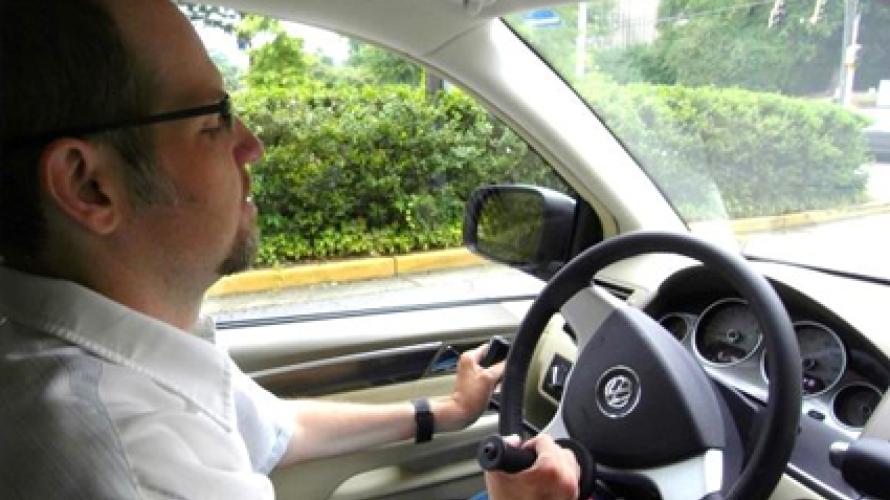
What you need to know?
- You may be able to continue driving safely again, depending on how serious your injury is and how much function you have regained.
- If you can drive, you may need to buy a vehicle that suits your unique needs after the injury.
- Vehicles can be altered with special equipment called “assistive technology” to help you drive safely after your injury.
- Equipment can be expensive based on your function and the type of equipment necessary.
- You should take specific steps before you return to driving; there are resources to help you.
How do I know if I can drive a vehicle again?
The amount of time after your injury is a major factor in deciding whether and how you can return to driving. You may see many improvements in your abilities several weeks or months after your injury. With time, you may regain some functions that could make driving possible. With time, the amount and cost of any needed special equipment may be reduced. You should look for these important signs that you are ready to drive again:
- You do not need narcotics to control your pain while you drive.
- You have good vision, or your vision can be corrected.
- You can control the muscle spasms and muscle tightening caused by the injury.
Your doctor can refer you to a driving rehabilitation specialist for a full evaluation to decide if you are ready and able to drive.
A full driving assessment will evaluate:
- Medical data/driving history/driving goals.
- Vision
- Strength and range of motion
- Cognitive ability (if indicated)
- Ability to transfer
- Wheelchair or other mobility device loading
- Behind-the-wheel driving to try out equipment options
How to find out what kind of assistive technology I will need.
Your doctor can refer you to a Certified Driver Rehabilitation Specialist (CDRS) near you who can do a driving evaluation for you. You can find a list of specialists and their locations at http://www.aded.net/ or by calling ADED at 866.672.9466.
The CDRS can help you decide what special equipment you might need to drive a vehicle, and what type of vehicle would be best suited to your needs. The CDRS may also know about special funding to help you get the equipment you need. To be evaluated by a CDRS, you will most often need a referral from a doctor. If you live in an area where there is not a CDRS close by then we recommend you visit http://www.nmeda.com/, and use the dealer locator tool to find automotive mobility dealers closest to you. These dealers are specially trained to help with your driving equipment needs. They will know of professionals in your area that can best meet your needs. NMEDA’s phone number is (866) 948-8341.
What kind of assistive technology is available?
There is assistive technology for many activities associated with driving; your choice will depend on what you need:
Getting in and out of a vehicle:Two of the main factors to consider in the return to driving after an SCI are vehicle entry and exit, and loading and unloading the mobility device if you use one.
- You may be able to transfer from a wheelchair into the vehicle and then load the manual wheelchair on your own.
- If you cannot load your wheelchair, there are adaptive wheelchair loading devices like the one shown on the left.
- If you cannot safely and independently transfer from the wheelchair to the driver’s seat, you may need a wheelchair-accessible vehicle that lets you drive or push your wheelchair into the vehicle.
- Some modified vehicles let you drive while sitting in the wheelchair.
- Whichever device you choose, the wheelchair must be secured while the vehicle is moving.
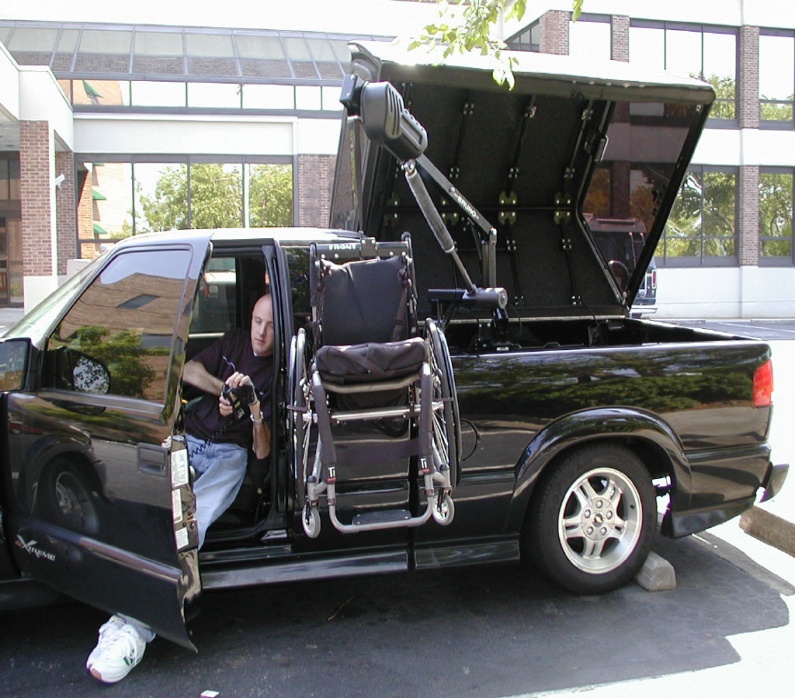
An example of a wheelchair lift for a pickup truck. Photo courtesy of Shepherd Center.
Operating the gas and brake controls: There are many different types of gas and brake controls; the most common are hand controls. Hand controls are available with many types of motion—push-pull, push-twist, push-rock, and push-right angle—so that drivers can use the one that suits them best. A CDRS can help you choose the best type for your injury or disability.
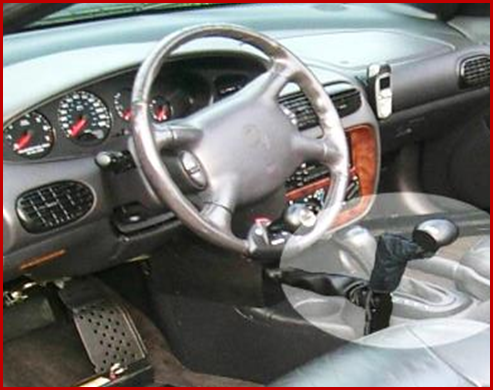
Controls can be mounted for the left or right hand. Pictured above is a right- floor–mounted mechanical hand control. Also a removable accelerator pedal block and steering wheel spinner knob can be seen. Photo courtesy of Shepherd Center.
Steering. Often a driver using hand controls will use only one hand for the steering wheel because the other hand is controlling the gas. A steering device like the one pictured here can help a driver steer efficiently with only one hand. The device can be placed on either side of the steering wheel, depending on which arm is strongest. The steering system can also be adapted so the driver can turn the wheel with less force using a smaller steering wheel, a separate electronic steering wheel, or even a foot-operated steering device.
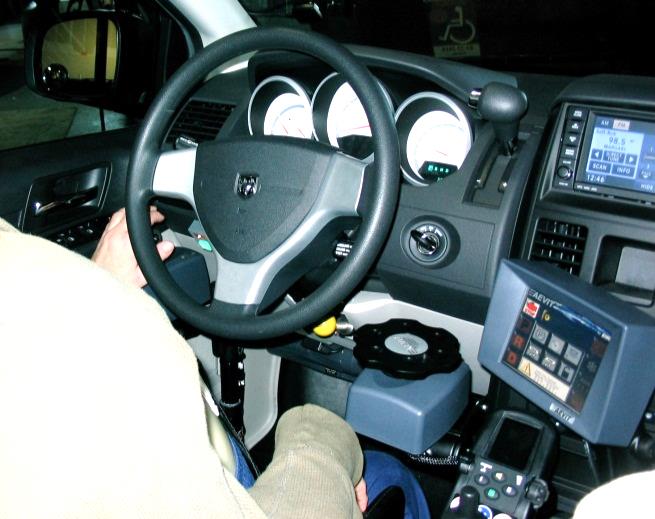
Electronic Wheel to be used with right hand for steering.
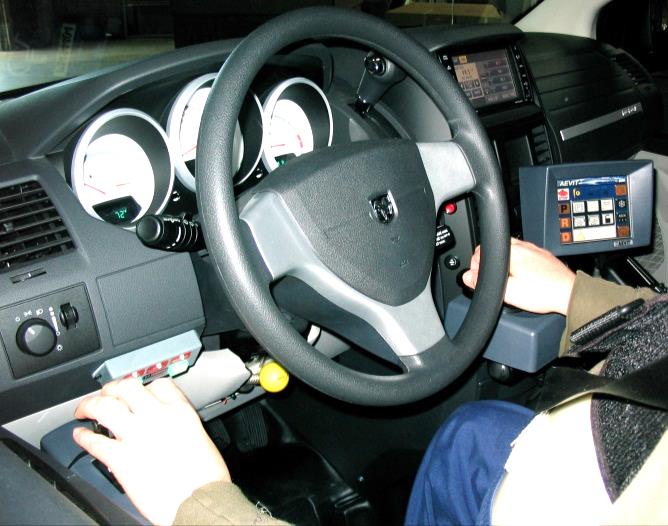
Electronic Gas/Brake Lever used with left arm and Electronic Wheel used with right arm for steering.
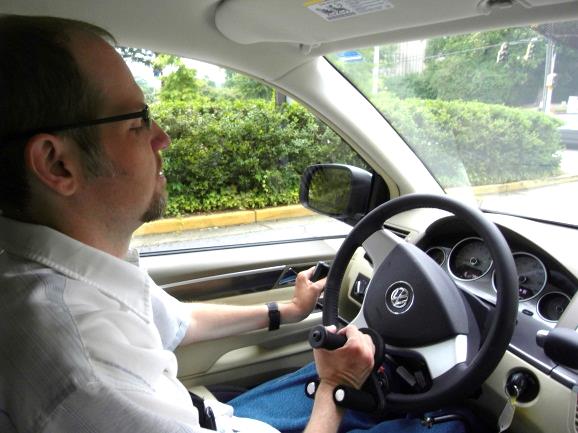
A tri-pin steering device allows someone without finger function to turn the steering wheel.
How will I pay for this equipment?
- Your State’s vocational rehabilitation (VR) program might help you buy, equip, and learn to use a vehicle. VR programs usually are for people who plan to return to school or work and who need costly high-tech equipment and/or a wheelchair-accessible vehicle.
- Most vehicle companies offer a rebate (about $1,000) to qualified people who buy a new vehicle. These rebates usually limit what equipment can be purchased.
- The Crime Victims’ Compensation Program might help if you are a victim of a crime (such as gunshot, drunk driver, violence). For more information, go to http://victimsofcrime.org, or call (202) 467-8700.
- Your State might have a trust fund that could help you. (For example, The Georgia Brain and Spinal Injury Trust Fund Commission helps Georgia residents with uninsured costs related to disability, including buying or modifying a vehicle. For more information, go to http://www.ciclt.net/bsitf.
- HelpHOPELive helps organize community-based fundraising efforts to help cover the costs of uninsured medical expenses for people with tragic injuries. For more information, go to http://www.helphopelive.org/about/.
- The U.S. Department of Veterans Affairs, or VA, offers grants to veterans who become disabled due to disease or injury associated with their military service, or who become disabled as a result of therapy, rehabilitation, or medical treatments provided by the VA. For more information, go to http://www.va.gov/.
When is the best time for me to get started?
Timing is everything. Take your time and get all the facts. Your body might need time to adjust to the effects of your SCI. For example, your motor functions might be different 1 month after your SCI than even a few to several months later. We urge you to take the time you may need after your SCI to be evaluated by a CDRS. The CDRS will evaluate your skills and help you decide what vehicle and equipment you will need. If you use a wheelchair, it will be important to coordinate your new chair with any plans for driving and also to have your own chair available before you purchase a vehicle so that the vehicle choice can support you and your chair.
Remember, an adapted vehicle can be expensive. It is important to truly understand your needs before buying anything. Do not feel pressured to make quick decisions. Rushing into a purchase will almost always make an appropriate vehicle more expensive than when a full evaluation is made at the proper time. When a purchased vehicle cannot be adapted to meet your needs, money and time are wasted in selling it and then buying a well-matched vehicle.
Authorship
Driving after Spinal Cord Injury was developed by John Anschutz in collaboration with the Model Systems Knowledge Translation Center.
Source: Our health information content is based on research evidence and/or professional consensus and has been reviewed and approved by an editorial team of experts from the Spinal Cord Injury Model Systems.
Disclaimer: This information is not meant to replace the advice of a medical professional. You should consult your health care provider regarding specific medical concerns or treatment. The contents of this fact sheet were developed under a grant from the National Institute on Disability, Independent Living, and Rehabilitation Research (NIDILRR grant number 90DP0012-01-00). The contents of this fact sheet do not necessarily represent the policy of Department of Health and Human Services, and you should not assume endorsement by the Federal Government.
Copyright © 2015 Model Systems Knowledge Translation Center (MSKTC). May be reproduced and distributed freely with appropriate attribution. Prior permission must be obtained for inclusion in fee-based materials.